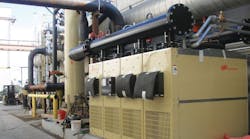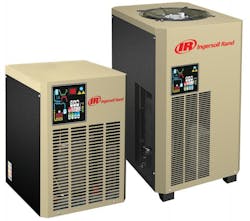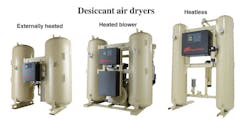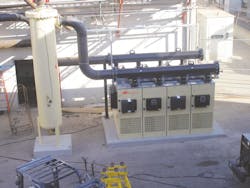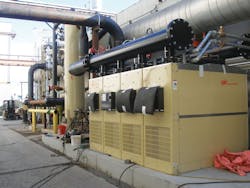Compressed air systems can account for a significant portion of a facility’s overall operating costs, so it goes without saying that air should be used wisely. One important factor is selecting the right type of compressed air dryer. Matching the dryer to a facility’s specific processes can save thousands of dollars in up-front costs and yield major dividends over the operating life of the system. The key is knowing how dry is “dry enough.”
Air dryers remove water before it can contaminate a system, but different dryers have different capabilities. Identifying the pressure dew point an application needs lets engineers determine the appropriate dryer. They fall into three general categories for most industrial applications: refrigerated, desiccant, and heat-of-compression (HOC) dryers.
Refrigerated dryers
Refrigerated air dryers reduce compressed air temperature through contact with a cold medium. Because cold air cannot hold as much moisture as hot air, water condenses out of saturated air as its temperature decreases — drying the air. A moisture separator in the dryer subsequently removes the water, which empties through a drain.
Although there are several variations of refrigerated dryers, they generally fall into two categories: non-cycling and cycling. The fundamental difference between the two is, as the name implies, the non-cycling dryer’s refrigeration system runs continuously — regardless of demand. Most non-cycling dryers include a hot gas bypass valve that keeps the dryer from freezing. Without this valve, compressed-air temperature can fall below the freezing point. Ice could form in the air circuit and block the entire system.
Cycling dryers help facilities conserve energy. Cycling dryers use the refrigeration system to cool a glycol-water mixture. This thermal mass exchanges heat with the warm air entering the system, thereby cooling the air and warming the fluid. The refrigeration system activates when the thermal-mass temperature rises above a set point. It cools the fluid to the desired low temperature, at which time the refrigeration system turns off. This type of operation uses only the energy required to address the incoming air load on the dryer, conserving energy.
Refrigerated dryers are widely used because they are cost-effective to purchase, operate, and maintain. For example, if an industrial facility only requires a dryer to run for 15 minutes every two hours, a cycling dryer can reduce electricity and energy costs when the system is not in use.
Refrigerated dryers yield air with a pressure dew point between 38° and 50°F. Although well-suited for general manufacturing and some specialty processes, they may not be appropriate for critical applications that demand extremely dry air.
Desiccant dryers
Unlike refrigerant-based units, desiccant dryers use porous desiccant beads to remove moisture from untreated air. Three types of desiccant dryers are widely used in the market: heatless, heated purge, and blower purge.
Heatless desiccant dryers use desiccant material contained within two towers to adsorb moisture from the compressed-air stream. Unprocessed, compressed air flows through the drying tower. The air passes through a diffuser screen and is distributed uniformly through the desiccant column. As air travels through the tower, the porous desiccant beads adsorb moisture, removing it from the air stream. This process generates heat, referred to as the heat of adsorption. The process typically raises air temperature by 15° to 20°F. The dry air, which can reach a pressure dew point of –40° to –100°F, exits the drying tower and travels downstream to the user’s equipment.
To remove the accumulated water from the desiccant, about 15% of the dry air emerging from the drying tower is channeled to the second, regenerating tower. In the regenerating tower, the air expands to atmospheric pressure as it moves over the desiccant beads. The dry, low-pressure air passes through the tower and collects moisture off the desiccant beads, aided by the heat of adsorption generated during the drying process. The towers switch from drying to regenerating in fixed intervals, letting one side continuously dry the process air while simultaneously regenerating the opposite tower.
Heated desiccant dryers — also referred to as heat reactivated or heated purge desiccant dryers — have a heater in the dryer’s regeneration circuit. This type uses a combination of heat and airflow to regenerate the desiccant adsorption beads.
In a heated desiccant dryer, untreated air from the compressor enters the drying tower and flows over desiccant beads. Similar to heatless dryers, the beads adsorb and remove moisture. Air exiting the drying tower can have pressure dew points ranging from –40° to –100°F.
While the drying tower treats compressed air, the opposite tower regenerates the desiccant. About 7% to 8% of the dried air is diverted for regeneration. This air passes through a heater, and the resulting extremely hot and dry air passes over the desiccant beads in the regenerating tower, liberating the moisture. The moist air is ultimately discharged through sound-attenuating mufflers. Given the energy costs associated with generating compressed air, heated purge dryers often cost less to operate than heatless dryers, as they use about 50% less compressed air for regeneration.
Heated blower dryers — also called blower purge dryers — do not require processed air to regenerate the desiccant in the regenerating tower. Instead, they rely on a dedicated blower that draws air from the surrounding environment.
The flow path to dry compressed air is the same as in the heated dryer configuration. Air enters the drying tower, flows across the desiccant, and discharges at the dryer outlet.
During regeneration, however, the blower draws air through a filter and sends it through a heater. The hot air travels into the regenerating tower where it is diffused, sent through the desiccant beads to extract moisture, recollected, and then exhausted through the purge-air outlet valve.
Thus, a notable difference between heated dryers and heated blower dryers is that blower purge dryers do not require 8% of the treated air for regeneration. The compressor’s total air capacity is available at the dryer outlet. A blower purge dryer that processes 500 scfm at the dryer inlet will have 500 scfm available at the dryer outlet, unlike other desiccant dryers. Like other desiccant units, heated blower dryers produce pressure dew points in the –40° to –100°F range.
Heatless, heated, and heated blower desiccant models produce the extremely dry air needed for sensitive applications such as chemical and pharmaceutical processing, but they typically require a larger initial investment than refrigerated dryers. The heated blower model has the greatest up-front cost but is often the most efficient to operate because it does not use compressed air for regeneration. In contrast, the heatless model is the most affordable of the desiccant dryer designs. However, the cost of the purge air used for regeneration may ultimately result in a higher total cost of ownership over the life of the equipment, when compared to heated and heated blower dryers.
Heat of compression dryers
Heat of compression (HOC) dryers are the most energy-efficient types. HOC dryers are desiccant dryers that capture and recycle heat generated by an oil-free air compressor during the compression process. Most HOC dryers have two towers filled with desiccant and deliver full compressor capacity at the dryer outlet.
Compressing air produces a significant amount of heat. With conventional refrigerated and desiccant dryers, a water- or air-cooled aftercooler removes that heat, and compressed air is delivered to the dryer at approximately 100°F.
In HOC dryers, the hot compressed air — typically around 340°F — travels directly from the oil-free compressor to the regeneration tower. Air flows through the tower, removing moisture from the desiccant column, and exits as hot, wet air. This moisture-laden air then passes through an aftercooler, where it emerges at approximately 100°F. The full compressed airflow then travels through the drying tower and exits with little moisture and a dew point of approximately –40°F.
HOC dryers coupled with Class 0 oil-free air compressors are ideal for critical applications in food, beverage, chemical, and pharmaceutical industries. This designation ensures compressed air moving through the system is free of water, oil, and particulates to ensure the quality of the end product. While HOC dryers require a larger capital investment than refrigerated or conventional desiccant dryers, operating costs can be on par with a light bulb.
For more information on compressed-air dryers, visit www.ingersollrandproducts.com.
Selecting the right dryerEvery facility has unique needs and demands, so there is not a “one size fits all” dryer suitable for all applications. Refrigerated, desiccant, and HOC dryers all have a place. Consider these factors when determining which dryer is the best choice:
It is important to determine how dry is “dry enough” for the application at hand. Once you’ve identified the minimum moisture content of the system, factor the performance, energy demands, and operational savings associated with each dryer type into the investment equation.;
|
